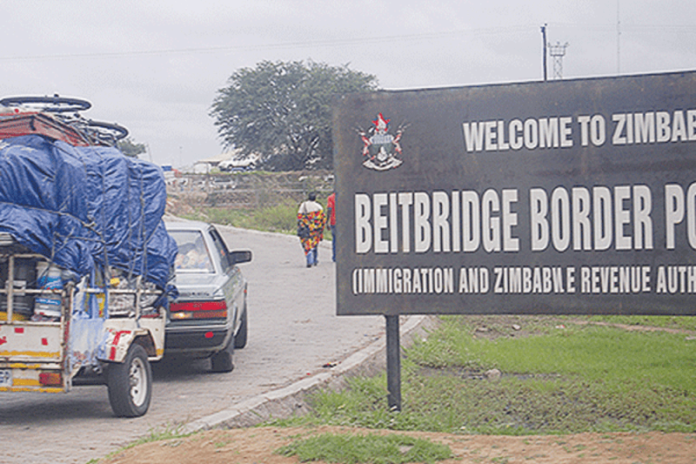
Sydney Kawadza
More people are trekking to South Africa, ostensibly, in search of greener pastures, goods and services as the country continues to be a dominant regional economic powerhouse in the SADC region.
This comes amid indications that the Beitbridge Border post between Zimbabwe and South Africa continues to host the largest number of travelling individuals in the region.
In Zimbabwe, economic challenges continue to push citizens to be constantly on the move with Zimbabweans dominating the number of people moving across borders in the SADC region.
Individual cross border travel in the SADC region also indicate that COVID-19 regulations have not deterred determined travellers from moving between states.
However, COVID-19 lockdown measures in Zimbabwe have contributed significantly to a drop in human traffic flow into the country.
Reports have, meanwhile, indicated that authorities continue to arrest more people traveling across borders without the requisite documents.
Most travellers in the region include informal traders looking for goods for re-sale in their native countries while South Africa attracts individuals in search of greener pastures.
However, stringent lockdown measures imposed by Zimbabwe have contributed to the reduction of movements into the country during the year.
The Zimbabwean government has banned imposed a Level 4 National Lockdown while reducing business hours, banning inter-city and non-essential travel.
According to the International Organization for Migration’s Regional Flow Monitoring Registry Report for July 2021, the Zimbabwe – South Africa (Beitbridge) corridor hosted the largest number of individuals who travelled during the reporting period.
This was followed by the Mozambique (Manica)–Zimbabwe corridor and the Malawi–Tanzania (Karonga) corridor.
The IOM works with national and local authorities to gain a better understanding of population movements throughout Southern Africa.
Through the setup of Flow Monitoring Points (FMPs), the IOM seeks to quantify migration flows, trends and routes while gaining a better understanding of the profiles of observed individuals at entry, transit or exit points.
The points include border crossing posts, bus stations, rest areas, police check points and reception centres.
Inter-regional migration from and within the Southern Africa is categorized along the following corridors; Zimbabwe (Forbes)–Mozambique, Zimbabwe (Chirundu) – Zambia and Zimbabwe – Botswana (Plumtree).
Other FMPs are Zimbabwe–South Africa (Beitbridge), Malawi (Mchinji)–Zambia (Mwami), Malawi–Tanzania (Karonga) and Malawi (Mwanza)–Mozambique.
A total of 20 596 movements were observed across 29 FMPs in SADC during the July 2021 period
“The Zimbabwe–South Africa (Beitbridge) corridor hosted the largest number of individuals with 7,829 (38 percent) followed by the Mozambique (Manica)–Zimbabwe (Mutare) corridor with 3,262 movements tracked (16 percent) and the Malawi– Tanzania (Karonga) corridor with 2,667 movements (13 percent),” the IOM report said.
The report further indicates that 7,829 cross-border movements were observed at Beitbridge with an average daily number flows of 340 people.
This, according to the report, represented an 11 percent decrease compared to April during which 384 individuals were observed on a daily basis.
The report further attributed the sharp decrease to the tightened lockdown measures by the government of Zimbabwe.
“Zimbabwe (60 percent) and South Africa (40 percent) were the countries of departure and South Africa (59 percent) and Zimbabwe (41 percent) were the countries of intended destination of individuals passing through the different FMPs.”
At the Chirundu One Stop Border Post, there was a 50 percent decline in the daily number of cross-border movements also attributed the lockdown measures in Zimbabwe.
However, Zambia (80 percent) had the highest number of individuals leaving the country while Zimbabwe (74 percent) was the main country of intended destination.
About 2,612 cross-border movements were observed at the FMPs between Zimbabwe and Mozambique during the period with the average daily number of flows decreasing by 18 percent compared to June.
“Mozambique (51 percent), Zimbabwe (46 percent) and Botswana (three percent) were the main countries of departure while Zimbabwe (50 percent) and Mozambique (48 percent) were the main countries of intended destination of individuals passing through the different FMPs,” the report states.
Cross-border movements between Zimbabwe and Botswana indicate quite a significant number of people crossing into the former than the latter and South Africa.
“Zimbabwe (79 percent), Botswana (17 percent) and South Africa (three percent) were the main countries of intended destination of individuals passing through the different FMPs,” the report said.
This could be attributed to a number of Zimbabwean citizens who returned or were deported from Botswana during the period.
Movement between Zambia and Malawi also indicates a large number of Zambians crossing into the neighbouring country 53 percent of the monitored movements compared to 47 percent moving in the opposite direction.
Zambia (57 percent) and Malawi (43 percent) were the countries of intended destination of individuals passing through the different FMPs, the report says.
The report also indicates a generous movement of people between Tanzania and Malawi while other individuals travelled from Burundi and Somalia.
Traffic flow between Mozambique and Malawi also indicate a general flow of Mozambicans travelling to Malawi while some individuals were observed while going to South Africa and Zimbabwe.








